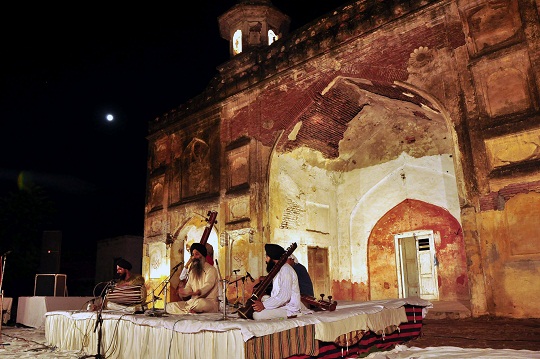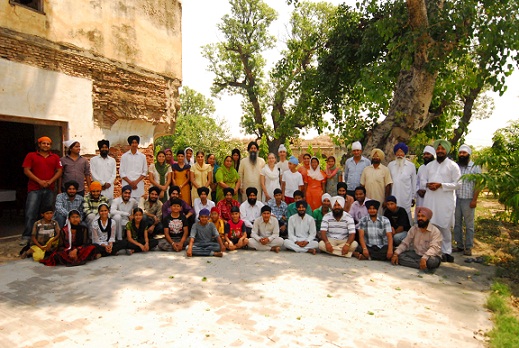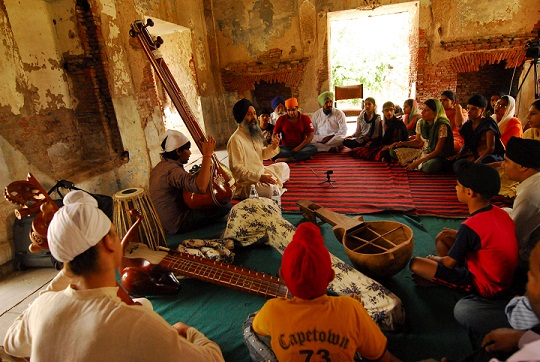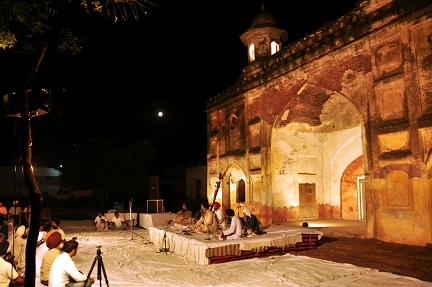Contribute
| Bhai Baldeep Singh In Concert |
Raj Melville
12/18/2012
On
Saturday, December 8, the Anad Foundation presented Bhai Baldeep Singh in
concert at the Koumantzelis Auditorium at Bentley University in Waltham. This
was the culminating event in a series of concerts, lectures and recitals on the
East Coast during November and December this year. Bhai Baldeep Singh is a
thirteenth generation exponent of Gurbani Kirtan, a maestro of Dhrupad and pakhawaj as well as teacher, poet and
luthier. The concert featured the Dhrupad Gurbani tradition and included music
from the Sufi, Sikh and Bhakti traditions. Bhai
Baldeep Singh is true renaissance artist who has not only mastered his music,
but has delved into past history to resurrect and preserve the origins of the
musical pieces. His passion for preservation drove him to seek out one of the
last remaining lute makers and learn the art of creating fine instruments that
were used during the time of the Gurus. He has founded the Anad Foundation that
is committed to the preservation and dissemination of the traditional knowledge
and culture of South Asia and the Anad Conservatory, an institute of arts,
aesthetics, cultural traditions and developmental studies at Sultanpur Lodhi in
Punjab, India. The conservatory is located in an ancient 12th
century fort and includes a 14th century mosque visited by Guru
Nanak, and a durbar hall where the Maharaja of Kapurthala received his guests. The
Foundation has compiled an international board of architectural and historical
experts to help preserve and recreate the Fort and its environs to faithfully
replicate the surroundings as they existed previously. When this architectural
and artistic heritage is finally restored the students will have the unique
experience of learning traditional music in an environment as close to when the
original music was played. The beautiful images on the slides highlight the
ageless beauty of the place and the current work ongoing in the conservatory including
classes for local youth, workshops for international students, concerts from
diverse world music traditions, poetry festivals, and demonstrations in
traditional arts such as spinning, weaving and dance. Saturday’s
musical program began with a pakhawaj
solo by Parminder Singh Bhamra, a senior student of Bhai Baldeep Singh. He skillfully
executed intricate patterns in tala pancham sawari, a fifteen beat rhythmic
cycle, with Rattan Bhamra providing the lehra
cycle on strings. Parminder’s dynamic recitation of bols, the poetry of percussion, added another dimension to the
powerful display of skill and rhythmic sound as he rendered traditional and new
compositions that showed the vast array of the repertoire taught to him by his
teacher, Bhai Baldeep Singh. Bhai
Baldeep was then joined by the accompanists and the sounds of raga kalyan alapa began to emerge. Raga kalyan is an evening melody
with a fourth sharp, which corresponds to the western Phrygian mode. A former student of flying, Bhai
Baldeep’s aeronautic abilities were demonstrated in beautiful patterns of
flight through the skyscape of raga
kalyan, ascending, descending, banking, diving in a weightless aerial
dance. In
about 38 minutes of improvisation (alap),
rag kalyan was fully explored in all
its potentials and melodic combinations, according to a variety of styles that
range from the Dagar-Vani, the Khandar-Vani, the Nauhar-Vani and the authentic
Gurbani tradition as transmitted in the lineage of Baba Jwala Singh. In rendering his alapa, Bhai Baldeep Singh was as if spinning the ragic (melodic) thread and then
simultaneously weaving an intricate phulkari
(a traditional Punjabi craft, in which embroidery is done in a simple and
sparse design over a bridal shawl) —patterns of seeking, of attaining and of
celebration, of japa - of dhyana— all embroidered albeit on the
fabric of silence. One could actually witness and savour meticulous exploration
and unfolding of the raga in all the
three octaves, an exquisite display of the grammar and vigour of the raga, as well as the poetic mood of kalyan. The semantic of the rag was perfectly expressed in
heterogeneity of embellishments, dynamics, and tempo that enchanted the
listeners’ mind in lieu of words. A dhrupad
composition from the guru times, "gun
naad dhuni anand ved", followed the alapa with more patterns and
variations decorating the lines of mystical poetry celebrating the virtues of
sound itself. This is an authentic masterpiece by the fifth Sikh master, Guru
Arjan Dev set in chartaal, a twelve
beat rhythmic cycle used in the medieval repertoire. Such a rare and precious
rendition of the shabad is what
Unesco would define as an intangible heritage of an ancient tradition. More
compositions followed and included treasures from the tradition as well as some
of Bhai Baldeep’s own lively compositions in ten beats (jhaptaal and sulphakta)
and seventeen beat (shikhar-taal)
tals. Raga Bageshwari, with its romantic flair
brought the audience to experience a different taste of Gurbani. The alap introduced an ancient musical
composition from the Golden Temple tradition, “kaunko kalanka raheo†by
Bhagat Namdev, set in chartaal, where
the author questions “who can remain impure chanting the Name?†Bhagat Namdev’s questions found an ideal
answer in the shabad “Hamari Piyari
Amritdhari’, that Bhai Baldeep Singh musically set in shikhar-taal, recreating the profound and powerful dimension of the
hymn. The
program ended with audience requests for more, which Bhai Baldeep kindly
accommodated with a sweet hymn in raga
bhairavi, a famous Khandar Vani composition, “jagat jananiâ€, in a crisp (drut)
geet-taal (seven beats) pattern. It
seemed the beginning of a new concert, refreshing like a morning melody and a
sweet sunray, when the shabad in tala dadra,
"yaarve nit sukh sukhendi sa mai
payyee", started at a slow peaceful pace. The end of the sonic journey
was actually celebrated with "sant
jana mil harjas gayeo", set in an original composition in ten beats by
Bhai Baldeep Singh, in which he shows his incredible talent as a contemporary
composer of the ancient tradition. Bhai
Baldeep’s singing was accompanied by Parminder Singh Bhamra on pakhawaj and Rattan Singh Bhamra on israj. Bhai Baldeep’s students, Dr.
Francesca Cassio, Nirvair Kaur Khalsa, and Siri Sevak Kaur Khalsa accompanied
with tanpura and vocals. The
event lasted for about three hours and a half, indeed a very unusual schedule
for the Western audience. Yet surprisingly listeners remained in the enchanted
sonic dimension of Gurbani, even after the stage lights went out and the lights
in the auditorium were turned on.
After the concert the guests chatted with the musicians over samosas and chai, warming the winter night with good company and praises for a
memorable evening. For more
information on the Anad Foudnation and Bhai Baldeep Singh’s work: http://anadfoundation.org/ To help
the foundation with its work; Anad USA, 790 E. 37th Avenue, Eugene, Oregon 97405 Contributors to this article are: Dr. Francesca Cassio, Associate Professor Music Dept., Sardarni Harbans
Kaur Chair in Sikh Musicology, Hofstra University, Hempstead - New York Nirvair Kaur Khalsa, Founder and Director of Khalsa Montessori School
in Tuscon, AZ
You may also access this article through our web-site http://www.lokvani.com/



